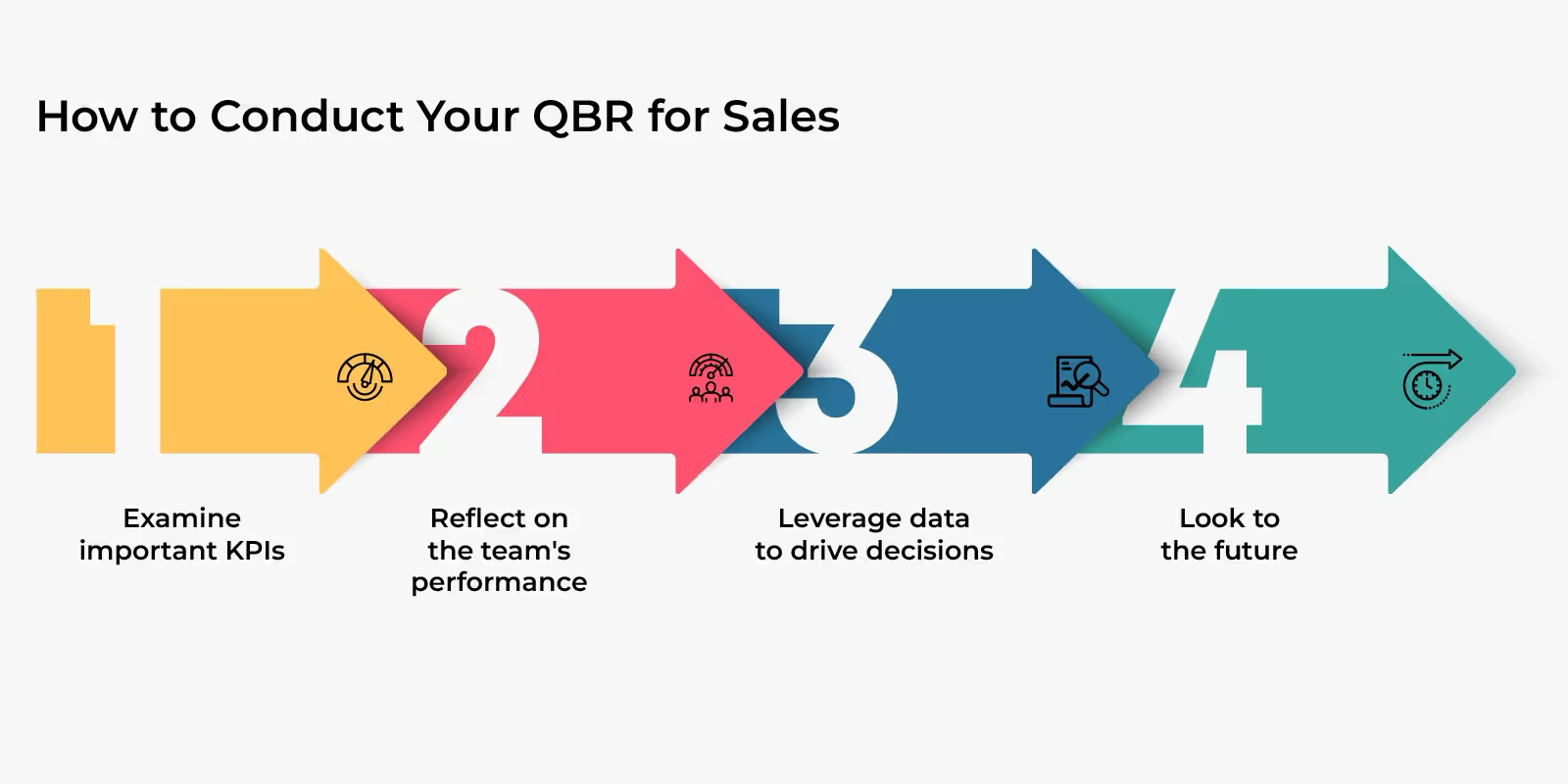
Blog
Sales QBR Success: A Handy Guide for Managers
November 8, 2024


Key Insights
Sales QBRs Made Easy: A Simple Guide for Managers!
It’s easy to get lost in the day-to-day hustle of prospecting, closing deals, and managing accounts. But how do you ensure that your team is moving the needle toward its bigger goals? This is where a Quarterly Business Review, or QBR, comes into play. Far from being just another meeting on the calendar, a QBR is a structured and strategic session designed to assess performance, identify growth opportunities, and set actionable goals for the future.
In this guide, we’ll dive deep into what makes an effective Sales QBR, cover each critical step in running one, and even provide a ready-made template to make your next QBR a success.
What Is a QBR in Sales?
A Quarterly Business Review is essentially a meeting where sales managers and their teams review the past quarter’s performance, examine data-driven insights, and realign on future goals. A time to pause, reflect, and adjust the sails as you navigate toward bigger sales targets. By checking in every three months, Sales QBRs ensure the team isn’t just working hard but working smartly toward its objectives.
While each QBR might look a bit different, the key is creating a space where managers and team members can discuss high-level achievements, opportunities, and obstacles. This way, the team remains aligned on strategy, while each member is motivated to contribute to the overarching goals.
How to Conduct Your QBR for Sales

Step 1: Examine Important KPIs
Before getting into specifics, take a high-level look at the most critical Key Performance Indicators (KPIs) for your team. These could include metrics like revenue, win rate, and average deal size. By setting a KPI framework for every QBR, you give your team a clear, quantitative picture of where they stand and which areas need attention.
- Pro Tip: Always compare these metrics to the targets set at the previous Sales QBR. This will help your team see progress (or gaps) in a meaningful context.
Step 2: Reflect on the Team’s Performance
Here, discuss individual and team-wide achievements, as well as any areas that need improvement. Did someone on the team close an especially tough deal? Was there a quarter-wide trend in lost deals? Take a moment to celebrate successes and learn from setbacks.
Pro Tip: Encourage open and constructive feedback. Use specific examples, and be prepared to handle any concerns with actionable next steps.
Step 3: Leverage Data to Drive Decisions
Use the data you’ve reviewed to make informed decisions. For instance, if you notice a decline in conversion rates, maybe it’s time to invest in new training or re-evaluate your pitch strategy. Data helps you move beyond guesswork, making each QBR more valuable and productive.
- Pro Tip: Consider bringing in insights from customer feedback and market analysis to enrich the discussion.
Step 4: Look to the Future
Finally, end the meeting by focusing on the upcoming quarter. Set clear goals, identify any potential challenges, and assign action items. Discuss whether any adjustments to the sales strategy are needed, and give each team member a chance to align with the new objectives.
- Pro Tip: Set SMART goals (Specific, Measurable, Achievable, Relevant, Time-bound) to make follow-ups easier and keep everyone accountable.
Sales QBR Template

To streamline your QBR process, follow this structured template:
1. Introduction and Setting Expectations
Kick-off with a brief agenda overview and set expectations for the meeting. Outline what you hope to achieve during the session, like uncovering performance blockers, setting realistic goals, and celebrating achievements.
2. Team Deal Wins and Review
Celebrate the wins from the quarter by discussing what worked well and exploring how similar approaches can be applied in other areas to amplify success. Encourage team members to share their stories and insights for a well-rounded, collaborative discussion. Recognizing achievements in this way not only highlights effective strategies but also creates a culture of shared learning.
To boost motivation and reward high performers, consider implementing incentives using Kennect’s Incentive Compensation Management (ICM) tool. With Kennect, incentives are managed automatically, taking the manual work out of tracking and distributing rewards. This head-free approach to incentives means team members can stay focused on performance, knowing that their hard work is accurately tracked and promptly rewarded.
3. Territory Plans
Review current territory assignments and performance. Determine if adjustments are needed or if certain territories require more support.
💡Know more about Territory Management: https://www.kennect.io/post/sales-territory-management

4. Prospecting Outreach Plans
Discuss the outreach strategies in place and assess what’s working and what isn’t. Are there specific tactics that have shown success? Focus on fine-tuning prospecting to align with quarterly goals.
5. Deal Losses and Support Needs
Identify deals lost during the quarter and analyze why they fell through. Use this time to identify trends that could indicate larger issues, and brainstorm ways to prevent future losses.
6. Takeaways and Action Items
Close out the QBR with clear action items. Assign specific tasks to team members, set deadlines, and establish accountability. Make sure everyone leaves with a clear understanding of the next steps.
Why Should Sales Teams Conduct Business Reviews?
Regular QBRs provide numerous benefits that make them essential to a successful sales strategy. By creating a space for open dialogue, they ensure all team members are aligned on goals and objectives, which significantly enhances collaboration. QBRs also enable sales teams to refine their approach by reviewing performance data and making necessary strategic adjustments. This flexibility ensures that the team is always operating with an optimal strategy, tailored to current market conditions and challenges.
QBRs foster goal-setting and accountability, as they provide a structured opportunity to set realistic, data-backed goals with clear responsibilities for each team member. This accountability drives stronger follow-through and more consistent results. Celebrating wins and giving team members a voice further boosts morale and motivation, which keeps the team engaged and committed. Altogether, these benefits make QBRs a powerful tool for aligning the team, motivating performance, and keeping sales efforts on track.
Conclusion
QBRs are more than just a quarterly routine; they’re a cornerstone of effective sales management. They provide the structure to review past performance, make data-driven decisions, and set goals for the future. Done right, QBRs can turn insights into action, inspiring your team to overcome challenges and consistently hit (or even exceed) their targets. So, set the stage for success, get your team onboard, and let the next quarter be your best one yet!
ReKennect : Stay ahead of the curve!
Subscribe to our bi-weekly newsletter packed with latest trends and insights on incentives.
Thank you! Your submission has been received!
Oops! Something went wrong while submitting the form.
Your data is in safe hands. Check out our Privacy policy for more info











